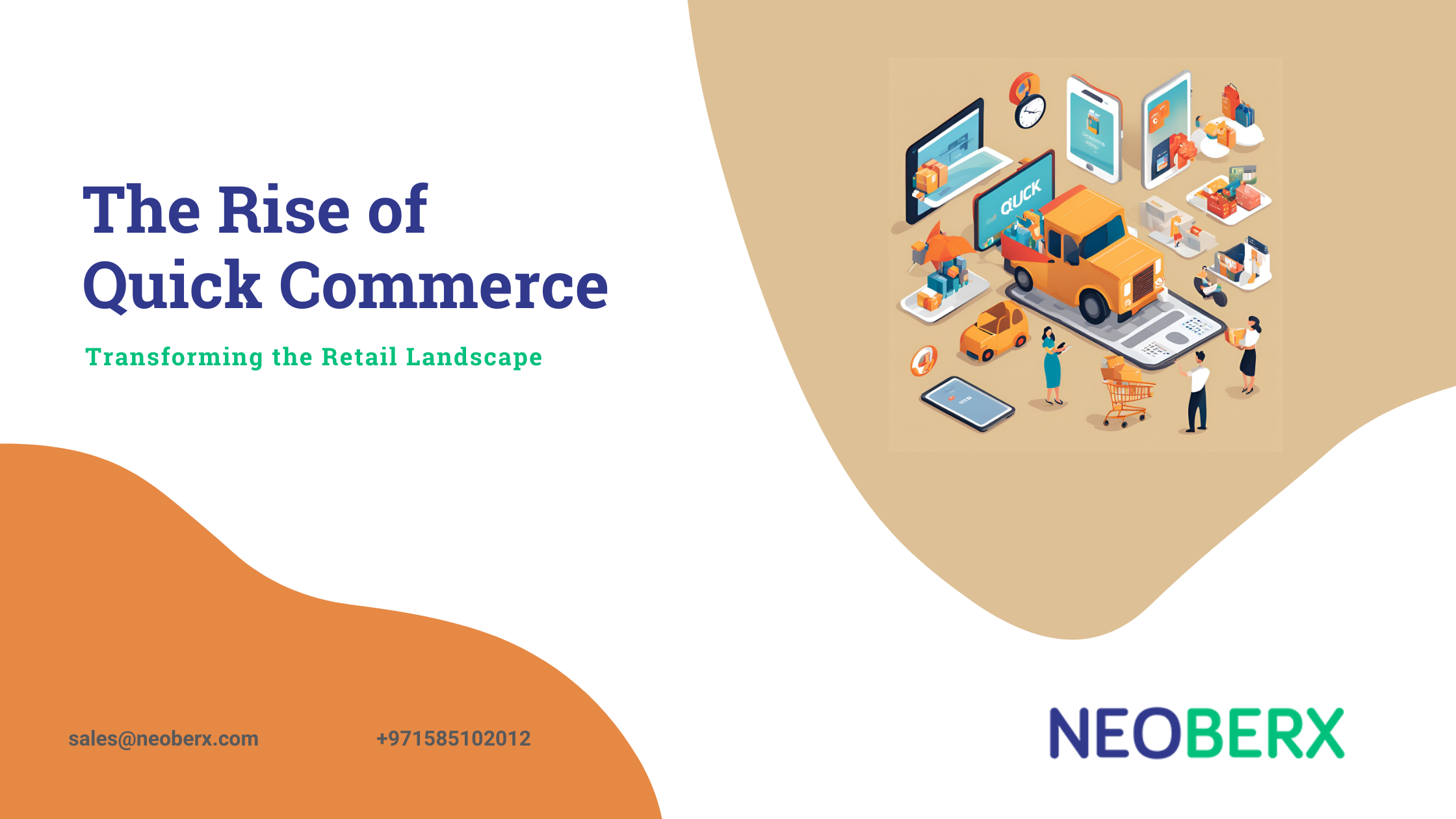Quick commerce, often referred to as Q-commerce, is revolutionizing the retail industry by offering ultra-fast delivery services that cater to the instant gratification desires of modern consumers. As online shopping continues to evolve, quick commerce is emerging as the next big thing, promising delivery times within minutes rather than hours or days.
What is Quick Commerce?
Quick commerce is an extension of traditional e-commerce, but with a focus on delivering goods to customers within a very short time frame, usually 30 minutes or less. This model is gaining traction due to its ability to meet the growing demand for speed and convenience in the shopping experience. Unlike conventional online shopping, which might require a day or more for delivery, quick commerce thrives on the immediacy of orders, often delivering within 10 to 30 minutes.
The Evolution of E-Commerce
To understand Quick Commerce, we need to look at how e-commerce has evolved over the years. From the early days of online shopping, where delivery could take weeks, to the standard two-day shipping offered by giants like Amazon, the industry has always aimed to reduce delivery times.
Quick Commerce is the next step in this evolution. It’s e-commerce on steroids, designed for a world where time is the most valuable commodity. This shift has been driven by advancements in technology, changing consumer expectations, and the rise of on-demand services.
How Quick Commerce Works
You might wonder, “How is it possible to get things delivered so quickly?” The answer lies in a combination of technology, logistics, and proximity.
- Micro-Fulfillment Centers: Instead of large warehouses located far from urban centers, Quick Commerce relies on small, strategically placed fulfillment centers. These micro-fulfillment centers are stocked with high-demand items and are located close to where customers live.
- Advanced Algorithms: These centers use sophisticated algorithms to predict what customers will need and when, ensuring that the right products are always in stock.
- Gig Economy Workers: Quick Commerce services often employ gig economy workers who can be dispatched at a moment’s notice to make deliveries.
- Real-Time Tracking: Customers can track their orders in real-time, knowing exactly when their delivery will arrive.
Why is Quick Commerce So Popular?
What makes Quick Commerce so appealing? It taps into our desire for instant gratification. We live in a world where everything is on-demand—entertainment, information, and now, products. The convenience of getting what you want, exactly when you want it, is irresistible.
Moreover, Q-Commerce has become particularly popular during the COVID-19 pandemic. As people avoided crowded stores and sought to minimize their time outside, the demand for fast, contactless delivery skyrocketed.
Key Players in Quick Commerce
Several companies have emerged as leaders in the Quick Commerce space. Let’s take a closer look at some of the key players:
- GoPuff: One of the pioneers in Quick Commerce, GoPuff operates its own network of micro-fulfillment centers, offering a wide range of products from snacks to household essentials.
- Glovo: This European startup has rapidly expanded its Quick Commerce operations, delivering everything from groceries to electronics.
- Deliveroo: Originally a food delivery service, Deliveroo has expanded into Quick Commerce, leveraging its existing delivery network to offer rapid grocery delivery.
- Zapp: A UK-based startup, Zapp promises delivery within 20 minutes and focuses on essentials like groceries, drinks, and over-the-counter medicines.
The Role of Technology in Quick Commerce
Technology is the backbone of Q-Commerce. Without the right technological infrastructure, it would be impossible to deliver products so quickly. Here are some of the key technological components:
- Artificial Intelligence (AI): AI is used to forecast demand, manage inventory, and optimize delivery routes. This ensures that the right products are available when and where they are needed.
- Mobile Apps: User-friendly mobile apps allow customers to browse products, place orders, and track deliveries with ease.
- Geolocation Services: These services help Quick Commerce platforms match customers with the nearest fulfillment center and the fastest available delivery person.
- Payment Gateways: Secure and fast payment processing is crucial for a smooth customer experience. Quick Commerce platforms integrate multiple payment options, including digital wallets and contactless payments.
Benefits of Quick Commerce
Q-Commerce offers numerous benefits, not just for consumers but also for businesses and the economy at large. Let’s explore some of these advantages:
- Convenience: The primary benefit is convenience. Consumers can get what they need without leaving their homes, and often without waiting more than half an hour.
- Time-Saving: In a world where time is money, Quick Commerce helps people save valuable time by eliminating the need for store visits.
- Increased Sales for Businesses: By offering fast delivery, businesses can attract more customers and increase sales, especially for impulse purchases.
- Job Creation: The rise of Quick Commerce has created numerous jobs, particularly in the gig economy, providing flexible work opportunities.
- Customer Loyalty: By providing a fast and efficient service, companies can foster customer loyalty and increase repeat business.
Challenges Facing Quick Commerce
Despite its many benefits, Q-Commerce is not without its challenges. These hurdles must be addressed for the industry to thrive in the long term.
- High Operational Costs: Quick Commerce requires significant investment in technology, infrastructure, and labor. The cost of maintaining micro-fulfillment centers and paying delivery workers can be high.
- Environmental Concerns: The need for rapid delivery often means more vehicles on the road, which can contribute to traffic congestion and pollution.
- Worker Exploitation: The reliance on gig economy workers raises concerns about fair wages, job security, and working conditions.
- Customer Expectations: As consumers get used to instant delivery, their expectations continue to rise. This puts pressure on Quick Commerce companies to deliver consistently and flawlessly.
Key Features to Look for in a Quick Commerce Platform
When choosing a quick commerce platform, consumers and businesses should consider several key features. These include:
- Delivery Speed: The platform’s ability to consistently deliver within the promised timeframe.
- Product Range: A wide selection of products to meet diverse consumer needs.
- User Experience: An intuitive app or website that makes placing orders easy and efficient.
- Pricing: Competitive pricing and transparency in delivery fees.
The Future of Q-Commerce in Retail
As consumer expectations continue to evolve, quick commerce is set to play an increasingly important role in the retail landscape. The demand for instant delivery is unlikely to wane, and businesses that adapt to this trend will be better positioned to thrive in the competitive retail environment.
Emerging technologies like drones and autonomous vehicles could further revolutionize quick commerce, making deliveries faster and more efficient. Additionally, the expansion of micro-fulfillment centers into suburban and rural areas could bring the benefits of quick commerce to a broader audience.
Predictions and Trends for Quick Commerce
Looking ahead, several trends are likely to shape the future of quick commerce:
- Expansion into New Markets: Quick commerce is expected to grow beyond urban centers, reaching smaller towns and cities.
- Sustainability Initiatives: As consumers become more environmentally conscious, quick commerce platforms may invest in greener delivery options.
- Personalization: Enhanced data analytics will allow for more personalized shopping experiences, with quick commerce platforms recommending products based on individual preferences.
Quick commerce is not just a trend; it’s a paradigm shift in how we shop. As technology advances and consumer demands evolve, quick commerce will continue to transform the retail landscape, offering unprecedented levels of convenience and speed.
Instant Commerce in Different Markets
Quick Commerce is a global phenomenon, but it doesn’t look the same everywhere. Let’s explore how Quick Commerce is evolving in different markets:
- United States: In the US, Quick Commerce has taken off in major cities, driven by companies like GoPuff and DoorDash.
- Europe: European cities like London, Paris, and Madrid have seen a boom in Quick Commerce, with startups like Glovo and Gorillas leading the way.
- Asia: In densely populated cities like Tokyo and Mumbai, Quick Commerce is growing rapidly, with companies like Swiggy and Zomato expanding their offerings beyond food delivery.
Why Choose Neoberx for Your Quick Commerce Solutions?
If you’re considering implementing Quick Commerce for your e-commerce store, partnering with the right eCommerce development agency can make all the difference. Neoberx stands out as a premier choice for building a successful Quick Commerce solution. Here’s why:
- Expertise: With years of experience in e-commerce development, Neoberx has the expertise to create a Quick Commerce solution tailored to your specific needs and business goals. Their deep understanding of rapid delivery systems ensures that your online store will be both efficient and effective.
- Customization: Neoberx offers customized solutions that align with your brand identity. Whether it’s a unique delivery model or specialized functionality, Neoberx ensures that your Quick Commerce setup stands out in a competitive marketplace.
- Support: From the initial design to ongoing maintenance, Neoberx provides comprehensive support. Their dedicated team is there to ensure your Quick Commerce solution operates smoothly and adapts to changing market demands.
- Results-Driven: Neoberx focuses on delivering results. Their strategies are designed to help you achieve higher traffic, better conversion rates, and increased sales, ensuring that your investment in Quick Commerce pays off.
Starting a Q-Commerce solution can be a rewarding journey with the right approach. By choosing Neoberx, you can leverage their expertise and dedication to build a successful e-commerce solution that thrives in the fast-paced world of rapid delivery. Ready to take the next step? Reach out to Neoberx today and let them help you bring your Quick Commerce vision to life.
Conclusion
Quick Commerce represents a significant leap forward in the world of retail. It caters to our desire for instant gratification and convenience, reshaping the way we shop. With rapid delivery times, technological innovation, and a focus on customer satisfaction, Quick Commerce is set to be a staple of modern life. However, as the industry grows, it will need to navigate challenges related to cost, sustainability, and worker conditions to ensure its long-term success.
Frequently Asked Questions (FAQs)
Q-Commerce, or Q-Commerce, is a type of e-commerce that focuses on delivering products to customers within a very short time frame, often within 30 minutes.
Unlike traditional e-commerce, which may involve longer delivery times, Quick Commerce is designed for ultra-fast delivery, typically using local fulfillment centers and advanced logistics
Examples include GoPuff, Glovo, Deliveroo, and Zapp, which specialize in rapid delivery of a wide range of products.
Key challenges include high operational costs, environmental impact, worker exploitation, and maintaining high customer expectations.
While Quick Commerce can contribute to environmental issues due to increased delivery traffic, some companies are working towards sustainability by using electric vehicles and eco-friendly packaging.


